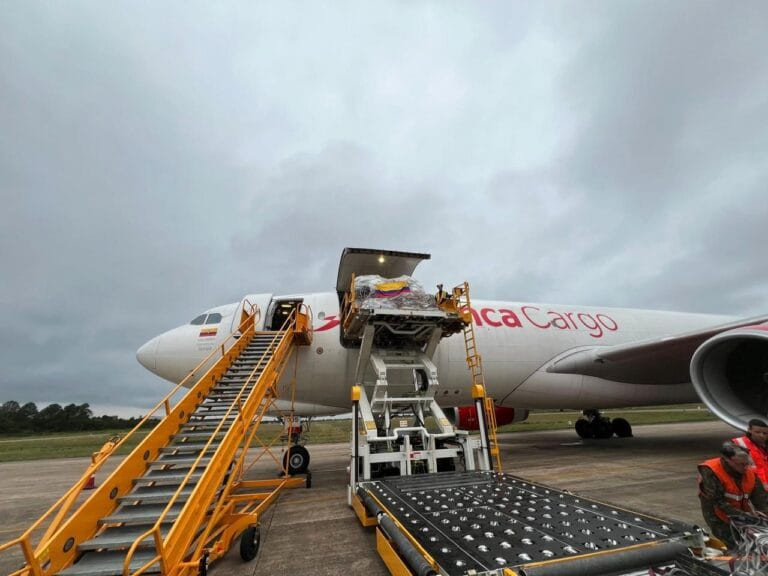Humanitarian aid is a lifeline for communities affected by natural disasters, crises, and ongoing challenges. From delivering essential medical supplies to remote areas to responding swiftly to emergencies, the logistics and aviation industries play a critical role in ensuring aid reaches those in need.
“Our cargo division is essential to sustainable management,” Senior Vice President of Avianca Cargo, Diogo Elias, explained.
“Much like our passenger aircraft, our cargo fleet serves as transformational hubs in the regions and communities where we operate. Through our cargo unit, we can deliver crucial aid to vulnerable communities and populations affected by natural disasters or recurring events, reaching those who need it most.”
Humanitarian missions require meticulous planning and collaboration among multiple stakeholders. Every step, from initial requests to the final delivery of aid, is critical.
“Our process aligns with the board-approved social strategy, which focuses on three key pillars: Humanitarian Assistance, Health, and Environmental Impact,” the team outlined.
“This ensures that our humanitarian assistance efforts meet the company’s standards and guidelines while also delivering timely support to vulnerable populations through the best social partnerships.”
A central element of this effort is the “Alliances for Development” programme, designed to amplify social impact through strategic collaborations.
“One of the key mechanisms we provide to our partners is our cargo division, which we use to transport humanitarian supplies, among other things. We first receive a request from our partners, managed directly by our sustainability team and supported by other areas of the company in terms of logistics,” they explained.
Speed and efficiency are the cornerstones of any successful humanitarian operation. “Natural disasters and emergencies strike without warning, and in these critical moments, the speed and effectiveness of our response can make a significant difference for those in need,” the team emphasised.
The numbers speak volumes. In 2024 alone, Avianca Cargo transported over 125 tonnes of humanitarian aid, including chemotherapy treatments, non-perishable food, blankets, toys, baby food, and medicines. Collaborative efforts with GOL Airlines facilitated the delivery of 50 tons of aid to Brazil, offering critical support during devastating floods. Other missions addressed emergencies such as forest fires in Chile and Colombia, showcasing the broad scope of their operations.
The team detailed the process: “We ensure we understand the type of cargo, its characteristics, the destination, and other relevant details. This guarantees the viability of the transport, helps us anticipate timelines, and secures necessary authorisations. Once the logistics are finalised, the cargo is transported and picked up by the partner at its destination.”
The logistical challenges of humanitarian air cargo are immense, particularly when responding to sudden crises.
“The biggest challenge is delivering aid promptly,” the team acknowledged.
“Emergencies require rapid action and ensuring that the aid is transported on time can be a logistical puzzle.”
To overcome these challenges, the team has developed efficient processes with their partners to facilitate a swift response. “We’ve streamlined our operations to ensure that, as soon as we receive a request, we can quickly manage the cargo and deliver it to its destination on time,” they explained.
However, the challenges are not without their rewards. “The greatest opportunity and benefit come from knowing that these populations are receiving immediate attention and that we are playing a crucial role in making this happen,” they reflected.
Power of humanitarian air cargo
In addition to chemotherapy treatments and medicines, the humanitarian cargo transported in 2024 included essential items such as non-perishable food, blankets, and baby food. Specific missions stand out as emblematic of the effort’s impact. Similarly, in Colombia, within our humanitarian aid shipments supported communities impacted by forest fires and other emergencies.
“Our ability to deliver aid is not limited to prioritised territories; we respond to any crisis or need as long as we operate in the affected region or neighbouring areas,” the team explained.
“Our social partners, such as ABACO, manage the humanitarian aid requirements, and once the cargo reaches its destination, they handle the distribution to the affected populations.”
This approach ensures that aid reaches the people who need it most, regardless of geographic constraints.
“In Colombia, our sustainability strategy prioritises areas such as La Guajira, Amazonas, San Andrés and Providencia, Nariño, and Bolívar,” they said. “In Latin America, we focus on El Salvador, Costa Rica, and Ecuador. However, in the event of a humanitarian emergency, the urgency of the situation takes precedence.”
Strong partnerships with trusted organisations are at the heart of successful humanitarian air cargo operations. “We collaborate with organisations such as the Colombian Red Cross, Airlink, and TECHO International,” they noted. “These collaborations allow us to extend our reach and maximise our impact in affected areas.”
The team underscored the importance of accountability and transparency in maintaining trust. “After receiving a request for humanitarian aid, we ask our partner or applicant for a detailed impact report. This part is managed directly by our social allies, who lead the projects while we support them with what we do best: flying,” they said.
To ensure integrity and adherence to standards, the team conducts regular audits. “We undergo a biannual audit conducted by our control and compliance department, along with KPMG,” they shared.
“These audits ensure that we are following the proper procedures for verifying individuals and institutions, maintaining neutrality in selecting social partners, and upholding our community impact reports.”
The transformative power of humanitarian air cargo lies in its ability to connect resources with those in need during their most vulnerable moments.
“The cargo division is more than a logistical operation; it’s a lifeline for communities in crisis. By providing immediate, effective support, we are fulfilling a core part of our mission to serve humanity,” they concluded.



